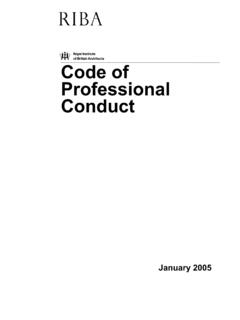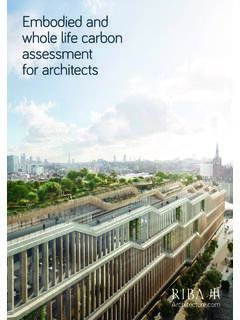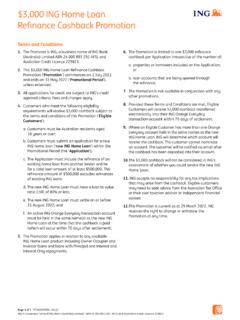Transcription of HomeWise - Royal Institute of British Architects
1 Space standards for homes#HomeWiseThe UK faces a significant and growing housing crisis. A failure to keep up with demand for new homes has driven up prices for homebuyers and created a critical shortage of social housing. As prices have risen and waiting lists have grown, UK homes have kept on shrinking particularly at the bottom end of the market. To address this, a number of cities across the UK, including London, have adopted their own minimum space standards. The UK does not collect reliable data on the size of new homes. However, in 2011, RIBA research showed that the family homes being sold by the UK s eight largest private housebuilders was on average 8m the size of a single bedroom smaller than the minimum standards drawn up for report helped to push the Government to take action and, in October 2015,a new nationally described space standard came into force, setting out detailed guidance on the minimum size of new homes.
2 Under the new standard, a new one bed, one person flat would have to be a minimum of 37m while a three bed, five person home would be a minimum of 93m .Unfortunately the new national standard is unlikely to have an impact in the short term. To adopt minimum standards in their area, Local Authorities will have to navigate an unnecessarily complex, costly, time-consuming and confusing need to build more homes and make sure that they are big people still feel that newly built homes are not big enough, and latest research suggests that consumers are right to be worried. In July and August 2015, the RIBA measured the size of new homes on over 100 randomly selected developments currently under construction across the UK from the country s 10 largest housebuilders.
3 We found that outside London, the average new three bedroom home is 4m smaller than the new standard. 4m may not sound like a lot, but it is the equivalent size of a bathroom. Our research shows that there has been a small improvement in the size of new homes since our 2011 research. However there is still a long way to go until new three bedroom homes meet the recommended minimum size of 93m . Even with the improvement, more than half of the new homes being built today are not big enough to meet the needs of the people who buy homes are still too small Outside of London the average new 3 bedroom home is missing 4m is an important factor when people are choosing a home and has a significant ongoing impact on their quality of life.
4 A lack of space can compromise the basic lifestyle needs that many people take for granted, like having enough space to store possessions, play, exercise or entertain friends. But it can also have more profound knock-on effects on health, educational attainment, family relationships and even social cohesion. The impact that space standards have on house sizes is already becoming clear. The average 3 bedroom home in London is now 25m bigger than in Yorkshire. That means on average, every new 3 bed home in Leeds, York or Scarborough is missing out on the equivalent of a double bedroom and a family living room. Homes in London are bigger than the rest of the countryNew three bedroom homes in London are 25 m bigger than in YorkshireIn October 2015, new rules were introduced giving Local Authorities the option to set a minimum space standard for new homes.
5 The rules were introduced to rationalise, simplify and streamline the planning system, but the process to set the new standard is overly complicated and onerous. Crucially, the space standard is optional. It can only be introduced through the planning system by including a policy in the local plan. To do this a Local Authority must first carry out a needs test and viability assessment to justify the policy. It may then need to carry out a full local plan review including public consultation and examination. All of these bureaucratic processes place an excessive and unnecessary burden on Local Authorities to justify something which the Government has already recognised is sensible and fair. It is complex and onerous for Local Authorities to apply the new space standard Image Credit: Keith HunterIn the first consultation of the Housing Standards Review, Government explained that the proposed new space standard.
6 Sets out reasonable minimum requirements for the gross internal (floor) area of new dwellings at a defined level of . If these are minimum reasonable requirements, how would it be reasonable for families to have less? Despite this, the space standard will only apply where the Local Authority chooses to introduce it and can demonstrate need and viability. The level of administration and red tape means that in many cases it could take several years to adopt. The work involved will put a strain on already stretched resources. Given that Local Plan teams are already understaffed, it is likely that when a Local Authority wants to implement a space standard it will need to wait for a wider Plan there are still further barriers. Even when successfully embedded in Local Plan policy, the space standard will be open to challenge from developers on site-specific viability grounds.
7 These challenges are likely to become more frequent and are very difficult and costly for Local Authorities to overrule. This means that more new homes will be sub-standard. It could take several years to set a space standard in the Local PlanImage Credit: Jack HobhouseIn 2013 the Government temporarily relaxed the planning laws to allow the conversion of office buildings into housing without the need to go through the planning process. Last year, these converted offices provided 20,000 of the 170,000 new homes in England. While many of these projects have delivered high-quality, sustainable new homes, the regulations mean that there are no safeguards to ensure this. Conversions are not required to meet space standards, or any other planning-based quality standards such as energy the country, two person apartments of less than 14m (the size of a typical bedroom) are being delivered.
8 Under the national space standard, the minimum floor area for any new home is 37m almost three times the size - yet these homes are allowed to be built because the rules do not allow them to be rejected on space grounds. Under the Housing and Planning Bill, this form of Permitted Development is due to be made permanent. This undermines the ability of Local Authorities to secure good quality, sustainable housing. Under the same legislation, there are new plans to extend Permitted Development rights to development on Brownfield sites meaning further developments could bypass the planning system and avoid locally adopted space space standard doesn t apply to some types of developmentImage Credit: Keith HunterThe RIBA believes that the best solution would be to embed the national minimum space standard within the Building Regulations that set the standards for housing design.
9 This would mean that all new homes across the country would be covered. A regulatory approach would create a level playing field and a fair housing offer wherever you live, irrespective of tenure. As an additional benefit, moving the space standard to building regulations would also free up over stretched local planning teams to focus on other all housing sectors, there is a desire for simplicity and consistency. When it comes to space, the Housing Standards Review has failed to deliver. During and since the review many housebuilders openly expressed a preference for space standards to go into the Building Regulations to give them the certainty they need when bidding for land. There is a will to do better; Government just needs to show the way, and finish the job it started.
10 It would be simpler, better and fairer if space standards were in Building Regulations. Join us in asking Government to act. Visit standards should be embedded in building regulationsImage Credit: Nick Kane Research Results20152011 Size of average 3 bed new home (sqm)Difference against recommended size (93 sqm)% of recommended minimumSize of average 3 bed new home (sqm)North and Humber84-990%83 West of excluding size of England s new Homes Our research provides a snapshot of new homes and the space inside them. We looked at the size of three bedroom homes developed by the top ten volume housebuilders by turnover. We recorded floor areas from Local Authority planning papers published online for a sample of 100 sites.


















